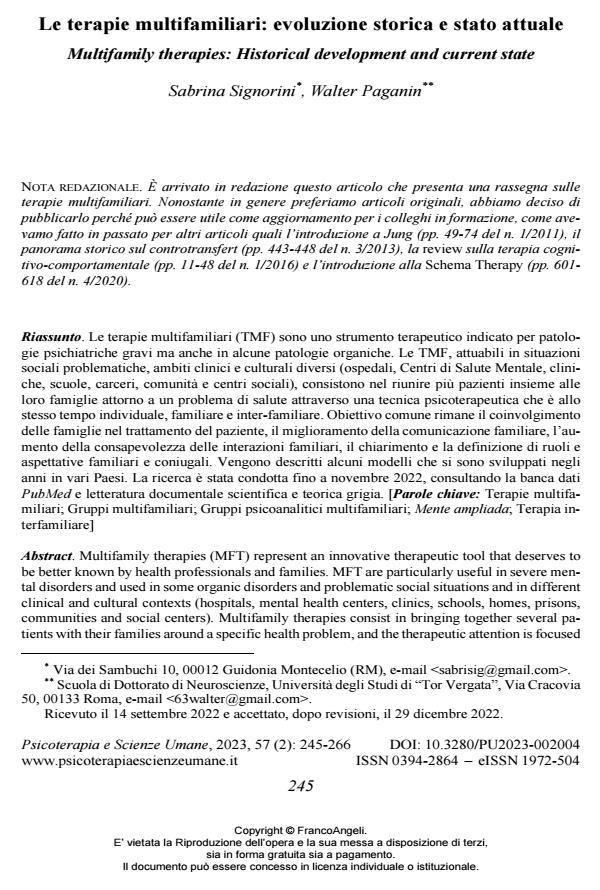Le terapie multifamiliari: evoluzione storica e stato attuale
Titolo Rivista PSICOTERAPIA E SCIENZE UMANE
Autori/Curatori Sabrina Signorini, Walter Paganin
Anno di pubblicazione 2023 Fascicolo 2023/2
Lingua Italiano Numero pagine 22 P. 245-266 Dimensione file 250 KB
DOI 10.3280/PU2023-002004
Il DOI è il codice a barre della proprietà intellettuale: per saperne di più
clicca qui
Qui sotto puoi vedere in anteprima la prima pagina di questo articolo.
Se questo articolo ti interessa, lo puoi acquistare (e scaricare in formato pdf) seguendo le facili indicazioni per acquistare il download credit. Acquista Download Credits per scaricare questo Articolo in formato PDF

FrancoAngeli è membro della Publishers International Linking Association, Inc (PILA)associazione indipendente e non profit per facilitare (attraverso i servizi tecnologici implementati da CrossRef.org) l’accesso degli studiosi ai contenuti digitali nelle pubblicazioni professionali e scientifiche
Le terapie multifamiliari (TMF) sono uno strumento terapeutico indicato per patologie psichiatri-che gravi ma anche in alcune patologie organiche. Le TMF, attuabili in situazioni sociali proble-matiche, ambiti clinici e culturali diversi (ospedali, Centri di Salute Mentale, cliniche, scuole, car-ceri, comunità e centri sociali), consistono nel riunire più pazienti insieme alle loro famiglie attor-no a un problema di salute attraverso una tecnica psicoterapeutica che è allo stesso tempo indivi-duale, familiare e inter-familiare. Obiettivo comune rimane il coinvolgimento delle famiglie nel trattamento del paziente, il miglioramento della comunicazione familiare, l’aumento della consape-volezza delle interazioni familiari, il chiarimento e la definizione di ruoli e aspettative familiari e coniugali. Vengono descritti alcuni modelli che si sono sviluppati negli anni in vari Paesi. La ri-cerca è stata condotta fino a novembre 2022, consultando la banca dati PubMed e letteratura do-cumentale scientifica e teorica grigia.
Parole chiave:Terapie multifamiliari; Gruppi multifamilia-ri; Gruppi psicoanalitici multifamiliari; Mente ampliada; Terapia interfamiliare
- Multifamily therapy in difficult-to-treat depression: an integrated and promising approach to rethinking clinical strategies Walter Paganin, in Frontiers in Psychiatry 1484440/2024
DOI: 10.3389/fpsyt.2024.1484440
Sabrina Signorini, Walter Paganin, Le terapie multifamiliari: evoluzione storica e stato attuale in "PSICOTERAPIA E SCIENZE UMANE" 2/2023, pp 245-266, DOI: 10.3280/PU2023-002004